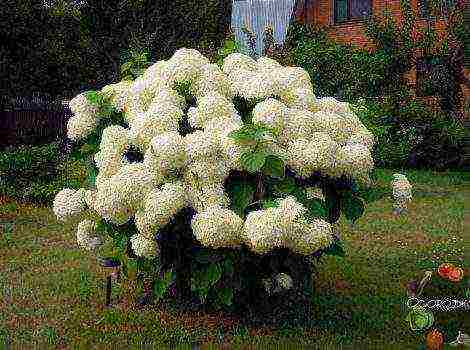Content
- 1 Growing echinacea from seeds
- 2 Planting echinacea outdoors
- 3 How to care for echinacea in the garden
- 4 Echinacea propagation by dividing the bush
- 5 Echinacea diseases and pests
- 6 Seed collection
- 7 Echinacea wintering
- 8 Types and varieties of echinacea with photos and names
- 9 Echinacea in landscape design
- 10 The healing properties of echinacea
- 11 Planting echinacea seeds in open ground - a first aid kit from nature
- 12 Planting echinacea
- 13 Outdoor Echinacea Care
- 14 Echinacea after flowering
- 15 Reproduction of echinacea
- 16 Diseases and pests
- 17 Benefits of Echinacea
- 18 Echinacea: how to grow on the site, the benefits of echinacea (video)
- 19 Growing echinacea from seeds
- 20 Planting echinacea outdoors
- 21 Echinacea care
- 22 The healing properties of echinacea
Echinacea is a perennial herb belonging to the Asteraceae family. Translated from Greek, the name means "prickly like a hedgehog."
This is due to the shape of the inflorescence: the core consists of numerous tubular flowers (like a hedgehog), framed by petals of a bright color, like a chamomile. Echinacea was first described by Karl Linnaeus in 1753 and was assigned to the genus Rudbenkiya, but after about 40 years it was allocated to its own genus.
Botanical description
The plant is rhizome. Its height is 1-1.5 m. The stem is erect, rough. Basal leaves are wide, oval with serrated edges, attached on long petioles. Stem leaves are almost sessile or sessile, lanceolate, arranged alternately.
The inflorescences-baskets (typical for Asteraceae) are large. The marginal reed inflorescences (petals) are colored white, pink, red. The core has a dark red, red-brown color. The fruit is a tetrahedral achene. Blooms from about mid-summer to late September.
Growing echinacea from seeds

Echinacea seeds photo
Generative (seed) propagation is applied to varietal plants (hybrids do not retain varietal characteristics during seed propagation).
Sowing in open ground
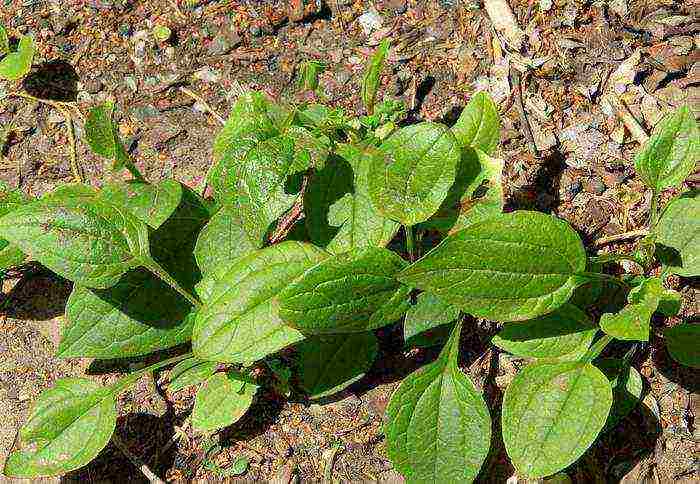
How to sow echinacea in the ground photo
- Echinacea seeds are sown in open ground in early spring or late autumn.
- Dig up the soil, level the bed, make shallow grooves (seeding depth of 1-2 cm) at a distance of 20-25 cm, sow seeds less often, sprinkle with a thin layer of soil, water.
- The first shoots are cut to a distance of 7-8 cm, then - 10-15, as a result, bushes are left at a distance of 25-30 cm for low-growing varieties and 40-50 cm for powerful plants. excess plants can simply be transplanted to a new location as seedlings.
- In the first year, Echinacea builds up the root system, and flowering will begin the next season.
Sowing seedlings at home
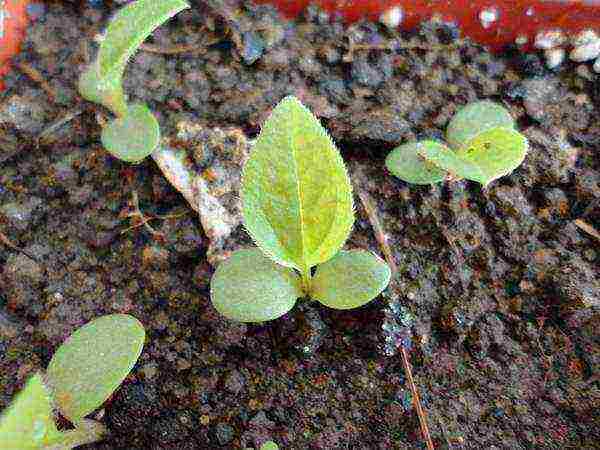
Echinacea from seeds at home photo shoots
To obtain ready-made spring planting seedlings, it is necessary to grow seedlings.
Please note that the seeds have a hard shell, so before planting they should be soaked in warm water, or better in a growth stimulator. Even so, germination takes about 1 month.
- Sow echinacea seeds for seedlings at the end of February... Sow in wooden crates, containers, or individual cups - whichever you prefer.
- The soil should be light, water and air permeable.
- Deepen the seeds by 5-10 mm.
- The distance between the seeds is 5-7 cm.
- Moisten the crops, cover with foil, place in a bright place, maintain the air temperature at 13-15 ºC.
- When seedlings appear, remove the film. Maintain moderate soil moisture.
- In early May, start hardening, leaving it outside, starting from a couple of hours, and gradually increase the time to a full day.
- Plant hardened plants in open ground in May, when the soil is already warmed up and the threat of recurrent frosts has passed.
Planting echinacea outdoors
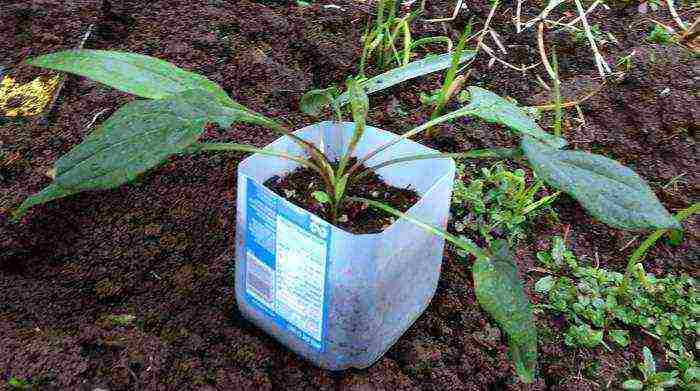
How to plant echinacea in open ground photo
Grows best in areas with bright sunlight.
The soil requires a fertile, neutral or slightly alkaline reaction. Light sandy soils or too wet soils are absolutely not suitable. If the soil is acidic, add garden lime.
- For seedlings, dig holes about 5 cm deep, for cuttings - a little more than the size of the root system.
- Maintain a distance between plantings of about 30 cm. Place a small amount of compost at the bottom of the planting hole.
If you purchased a large seedling in a container, dig a hole about 40 cm deep. Cover it with a third of a mixture of garden soil, compost, sand in equal proportions. Cross the fathoms together with the earthen lump. The root collar should remain at the same level as when growing in a container.
How to care for echinacea in the garden
- Water the echinacea generously and frequently. Do it better in the evening.
- Remove weeds regularly, periodically loosen the soil.
- From the second year of life, start feeding. Apply organic matter or complex mineral fertilizer twice a season (in early spring and after flowering).
- If there is no need to collect seeds, cut off wilted inflorescences with a piece of stem to the first green leaf.
Echinacea propagation by dividing the bush
Most often, the plant is propagated by dividing the bush (thus the varietal characteristics are preserved). You can share a 4-5 year old echinacea bush. Perform the procedure in spring (April) or autumn. Carefully dig out the bush, divide it into parts so that each contains 3-4 buds of growth, plant it.
Echinacea diseases and pests
If the summer is rainy with temperature fluctuations, powdery mildew is possible: shoots and leaves are covered with a whitish bloom. It can also happen from an excess of nitrogen fertilizers. It is necessary to carry out the treatment with Bordeaux liquid or colloidal sulfur.
Cercosporosis, septoria are dangerous fungal diseases that manifest themselves in various spots on the leaves. The plant becomes weak and may die. Remove the affected areas, treat with a fungicide.
When viral diseases are affected, leaves turn yellow and dry, peduncles are deformed. Affected plants must be removed from the site and burned; treat the growth site with a strong solution of manganese.
Pests: bedbugs, drooling penny, slugs. Collect gastropods by hand, use traps. Insects will help get rid of insecticide treatment.
Seed collection
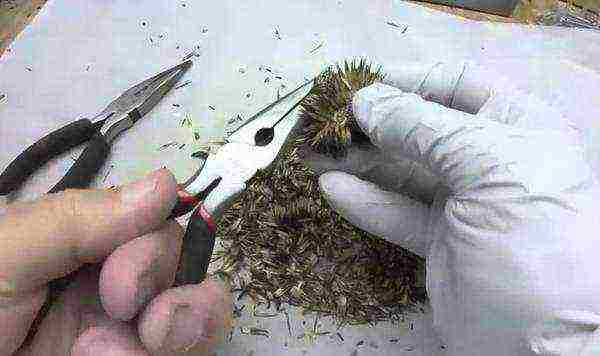
How to collect echinacea seeds photo
Seed ripening is uneven. When the center of the core darkens, these seeds can be harvested. Carefully remove them (it is better to put on a rag glove), peel off the remnants of inflorescences and dry. Seeds quickly lose their germination.
Echinacea wintering
Echinacea is frost-resistant. Young plants and, if a cold, snowless winter is foreseen, should be covered for the winter. At the end of October, cut off the stems, mulch the root collar with compost, cover with dry foliage and spruce branches on top.
Types and varieties of echinacea with photos and names
In the natural environment, there are only 9 types of echinacea. Echinacea purpurea is mainly cultivated with bred varieties and hybrids, less often - strange echinacea.
Echinacea purpurea Echinacea purpurea
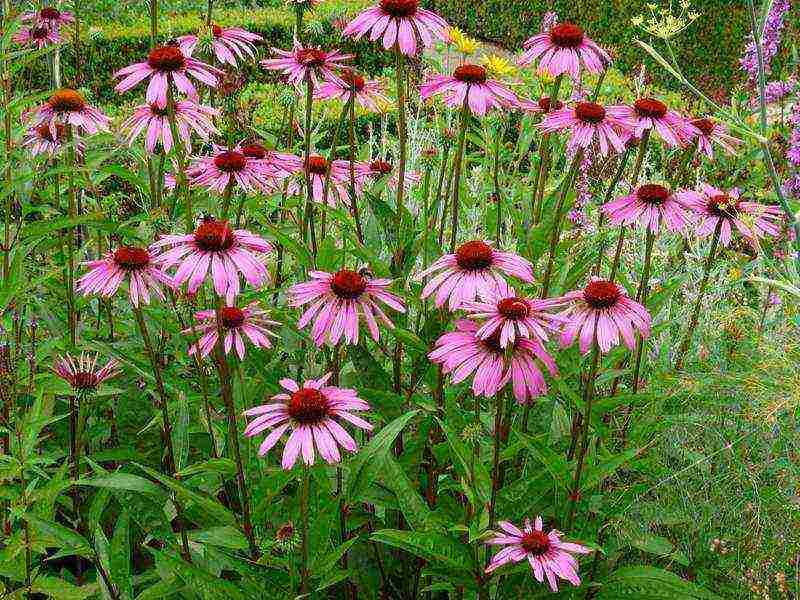
Echinacea purpurea echinacea purpurea cultivar rubinstern photo
Plant height is about 1 m. Stems are erect. Basal leaves are wide, oval, attached on long petioles; stem - oblong, sessile. The ligulate flowers are about 4 cm long, have a purple-pink color, the core is red-brown.
Varieties:
Granatstem - plant height reaches 1.3 m. The ligulate flowers have two-toothed tops, are painted in a purple hue, the core is brown. The diameter of the inflorescence is 13 cm.
Zonnenlach - reaches a height of 1.4, the diameter of the basket is 10 cm. The tops of the reed inflorescences are divided into 3 teeth, the color is dark red, the core is brown.
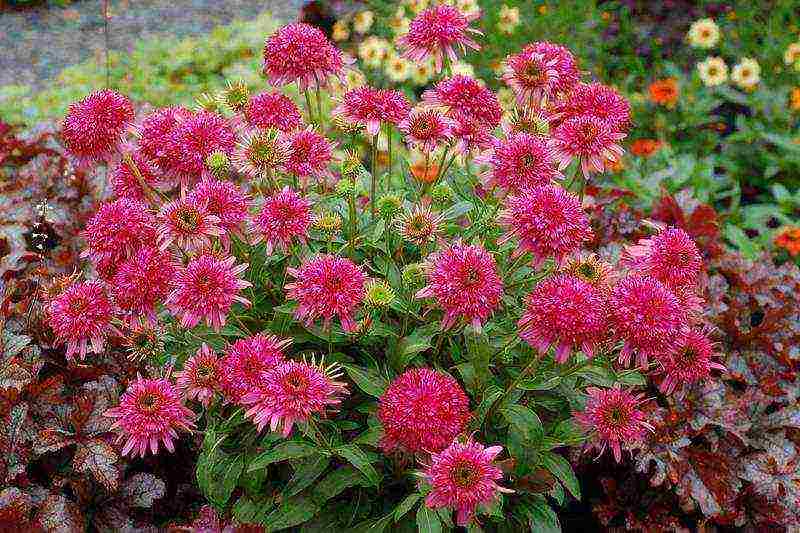
Echinacea purple terry variety Cranberry Cupcake photo
Cranberry Cupcake is a very interesting variety. The core is massive, lush, consists of hundreds of small tongues, the color is dark pink, the petals are colored light purple.
The King - the stem rises by 2 m. The massive inflorescence reaches a diameter of 15 cm. The color is red-pink.
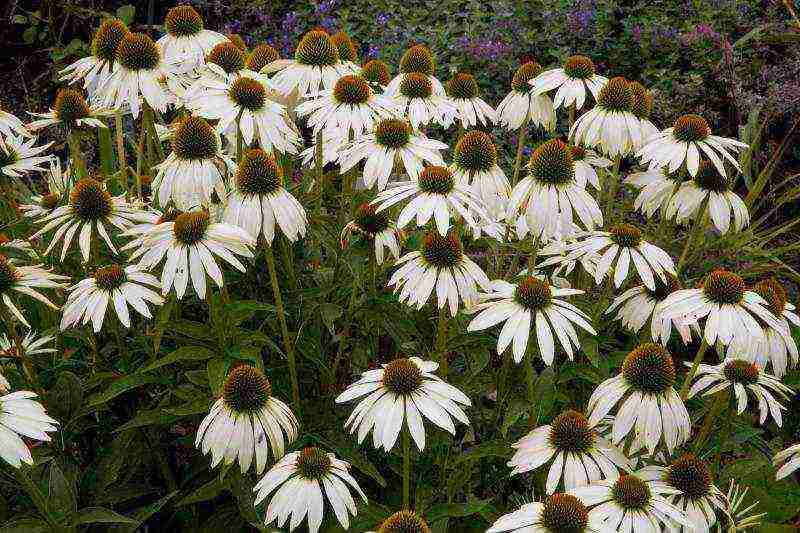
Echinacea purpurea white variety Echinacea purpurea White Swan photo
White Swan - white inflorescences.
Indiaca - pale pink to light brown.
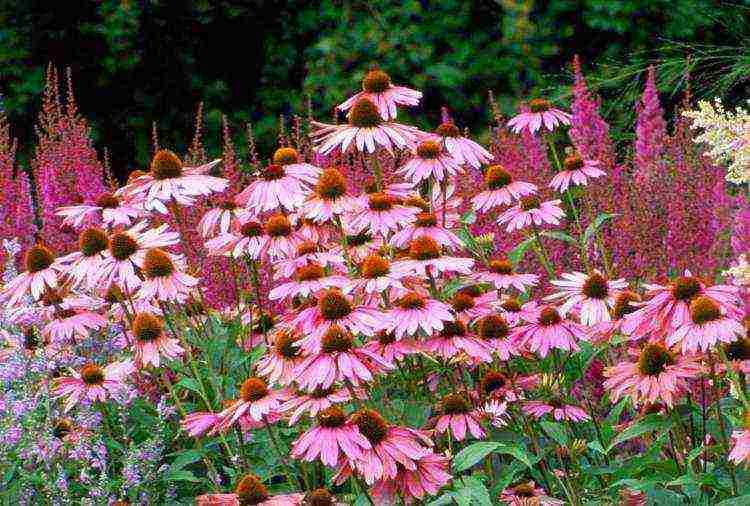
Echinacea purpurea cultivar Magnus Echinacea Purpurea ‘Magnus’ photo
Magnus - plant height is 1 m. Very popular variety. The core is light brown in color, the petals are pale pink.
Ruby star - echinacea 70-80 cm high, the diameter of the basket is about 14 cm. The core is brown in color, the petals are crimson.
Echinacea Sunset Echinacea x sunset
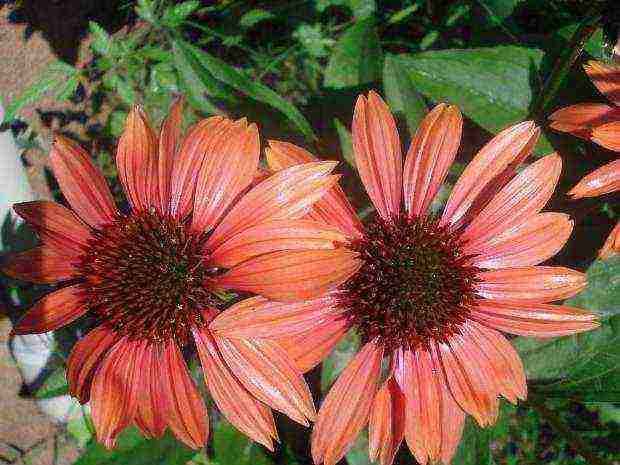
Echinacea Sunset Echinacea x sunset photo
A series of hybrids developed by Richard Skoll. They are notable for their large inflorescences. Reed inflorescences are bent, can have the color of mango, mustard, strawberry, peach, exude a wonderful aroma. Henna-colored core.
Popular varieties:
Julia (from the Butterfly Kisses series) - reaches a height of 45 cm. The flowers are bright orange.
Cleopatra - the diameter of the inflorescence is 7.5 cm. Petals are sunny yellow.

Echinacea Evening Glow Echinacea Evening Glow photo
Evening Glow - cone-shaped core, dark color. Reed flowers are yellow with an orange stripe and pinkish tint.
Cantaloupe - the color corresponds to the name. The ligulate flowers are arranged in 2 rows, have a pink-orange tint, the core is shaggy, of a darker shade.
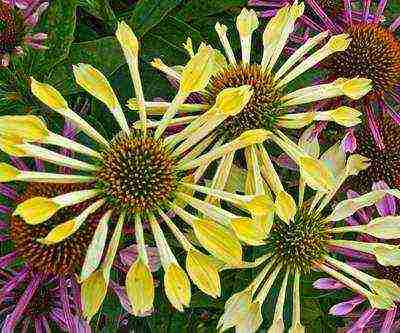
Echinacea Passion Flute Echinacea Passion Flute photo
Passion Flute - ligulate inflorescences are twisted into a tube, painted in golden yellow, the core has a greenish-mustard tint.
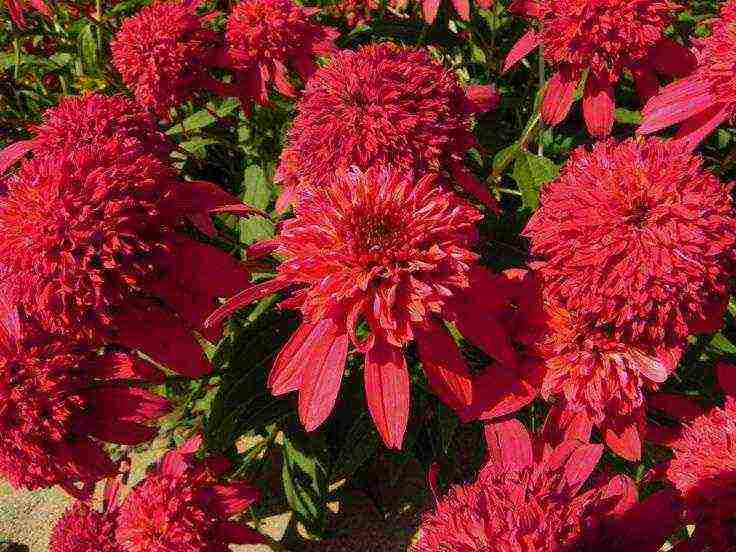
Echinacea Double Scoop Cranberry Echinacea Double Scoop Cranberry photo
Double Scoop Cranberry is a catchy cranberry echinacea.
Echinacea strange Echinacea paradoxa

Echinacea weird Echinacea paradoxa in garden design photo
Notable for the bright yellow color of long petals bent down. The plant forms powerful bushes, hardy in dry summers.
Echinacea in landscape design

Echinacea in landscape design photo with other flowers
Echinacea is good in group plantings, as a decorative element in the background and middle ground in mixborders. Combines with phlox, aster, monarda, blackhead, geyhera, antennae, salvia, aruncus, hydrangea, lilies, astilba, fescue, Japanese spirea, bells, catnip, veronica, look great against the background of coniferous bushes and trees.
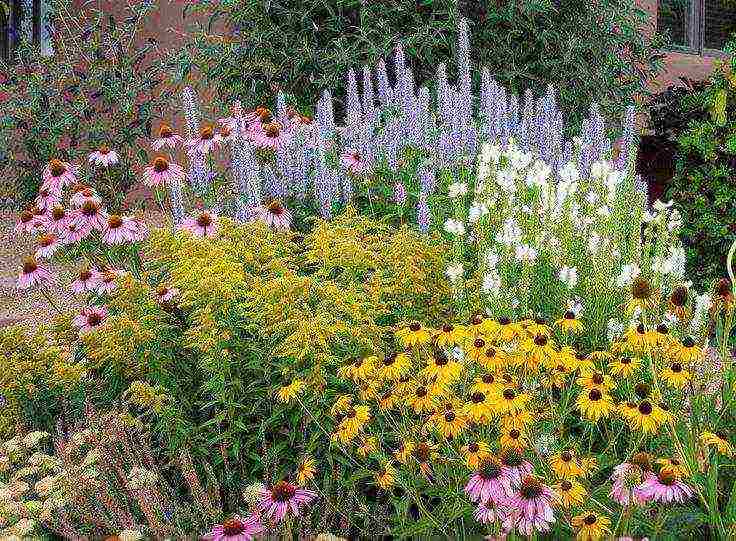
With what to plant echinacea photo flower beds
An interesting combination of echinacea in group plantings with flowers such as decorative yarrow, physostegia, alder cage.
The healing properties of echinacea
The rhizome contains essential and fatty oils, enzymes, resins, various trace elements (silver, selenium, manganese, zinc, calcium, potassium). The ground part is rich in polysaccharides, tannins, flavonoids, organic and hydroxy brown acids, essential oils, and resins.
Echinacea preparations (plant juice, decoction, tincture) have antiviral, antimicrobial, antifungal, wound-healing effects, strengthen the immune system.
Contraindications for use are individual intolerance, pregnancy and lactation, diseases: leukemia, collagenosis, multiple sclerosis, progressive tuberculosis.
Planting echinacea seeds in open ground - a first aid kit from nature
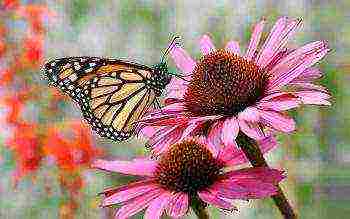 Echinacea boosts immunity by producing interferon, which has a beneficial effect on the human body. The tincture is prepared from the inflorescences of a beautiful echinacea flower. It helps in the treatment of neurasthenia, sinusitis, laryngitis, cystitis, influenza, prostatitis, and is often prescribed in combination with antibiotics to maintain immunity. Topically used to treat boils, urticaria, insect bites, herpes. Echinacea actively fights infectious diseases, Escherichia coli. It can rightfully be called a natural effective antibiotic and immunomodulator. Scientists are still studying this plant to this day, as it hides many more secrets.
Echinacea boosts immunity by producing interferon, which has a beneficial effect on the human body. The tincture is prepared from the inflorescences of a beautiful echinacea flower. It helps in the treatment of neurasthenia, sinusitis, laryngitis, cystitis, influenza, prostatitis, and is often prescribed in combination with antibiotics to maintain immunity. Topically used to treat boils, urticaria, insect bites, herpes. Echinacea actively fights infectious diseases, Escherichia coli. It can rightfully be called a natural effective antibiotic and immunomodulator. Scientists are still studying this plant to this day, as it hides many more secrets.
 The flower itself is a stem up to 1 m long, straight stems with a light rough structure, basal leaves are collected in a rosette, baskets can reach a diameter of 15 cm.Echinacea flowering in open ground begins in different ways, depending on the method of planting: from the second year when sowing in open ground or in the year of planting, if through seedlings. It runs from July to September. The most popular is Echinacea purpurea.
The flower itself is a stem up to 1 m long, straight stems with a light rough structure, basal leaves are collected in a rosette, baskets can reach a diameter of 15 cm.Echinacea flowering in open ground begins in different ways, depending on the method of planting: from the second year when sowing in open ground or in the year of planting, if through seedlings. It runs from July to September. The most popular is Echinacea purpurea.
They plant it on a personal plot to decorate the landscape, in a flower garden, or for medicinal purposes. Everyone can grow a beautiful echinacea flower, since planting and care is not difficult at all. Suitable for any climate, it is not afraid of rain or heat, it will also tolerate not the ideal composition of the soil. It goes well with astilba, phlox, aster. This is a great honey plant.
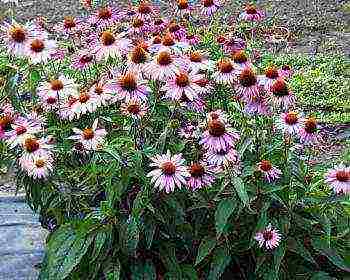 How to plant echinacea seeds
How to plant echinacea seeds
Choose an open, sunny area for planting. If the soil has an acidic pH, then ferment. Seeds with a shelf life of more than 1 year have a very low germination rate.
Echinacea seeds are planted in open ground at the end of April-May. Seedlings appear in 2-4 weeks. However, in the conditions of central Russia, it is recommended to grow echinacea through seedlings.
For growing seedlings, seeds are planted in late February-early March, after soaking in a growth stimulator, pressed in 0.5-1 cm and sprinkled with a thin layer of sand on top. Germinated at a temperature of 13-15 ° C. Sandy soil or a mixture of garden and wood ash is used as a substrate. Seedlings appear within 2-5 weeks, at this time it is necessary to maintain soil moisture. At night, crops can be covered with polyethylene, creating a greenhouse effect.
Young seedlings are transferred to open ground in May, when their height is 10-15 cm. They are planted in holes, at the bottom of which a drainage layer is made of crushed stone or expanded clay. The distance between the holes is 30-40 cm.
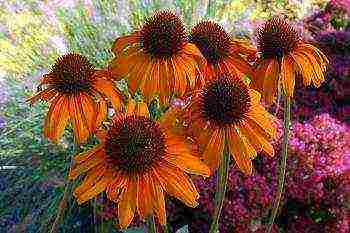 Echinacea care
Echinacea care
The plant does not like frequent watering, once every 2 weeks is enough, in the heat it is possible more often. Water in the morning or evening. Weeds, faded inflorescences are regularly removed. Transplanted after 4 years in the spring for rejuvenation. Top dressing begins a week after planting and during the budding period, using a complex mineral fertilizer or organic matter in the form of a mixture of compost and wood ash. This will allow the plant not to stagnate, but to develop and bloom luxuriantly.
Waterlogging of the soil or stagnant water causes diseases, spots appear on the leaves caused by the spores of Cercospora, and the flower dies from this. Found damaged parts are removed or treated with a fungicide. The curvature of the peduncles is caused by viruses. Diseased plants are immediately removed from the site so that other plants are not harmed.
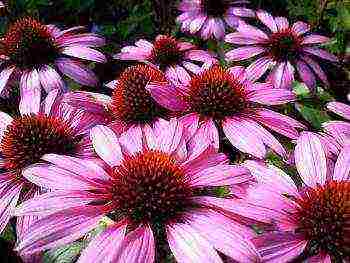
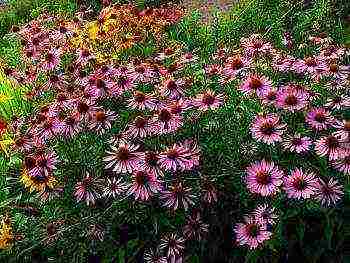
Of the pests, echinacea is loved by bedbugs, slugs and slobbering pennits.
For the winter, at the end of October, the ground part is cut off, and the root collar is mulched with peat, spruce branches or compost. Cover with a layer of dry leaves on top. Such a shelter for the winter will allow the plant to successfully overwinter and not die in the snowless season.
Echinacea is usually propagated by seeds or by dividing the bush. The division is carried out for those plants whose age is 4-5 years. In early spring, the rhizome is divided into several parts so that there are 3 or more buds on each division.Then they are kept in a growth stimulator for 2-3 hours, after which they are planted so that the root collar is at ground level.
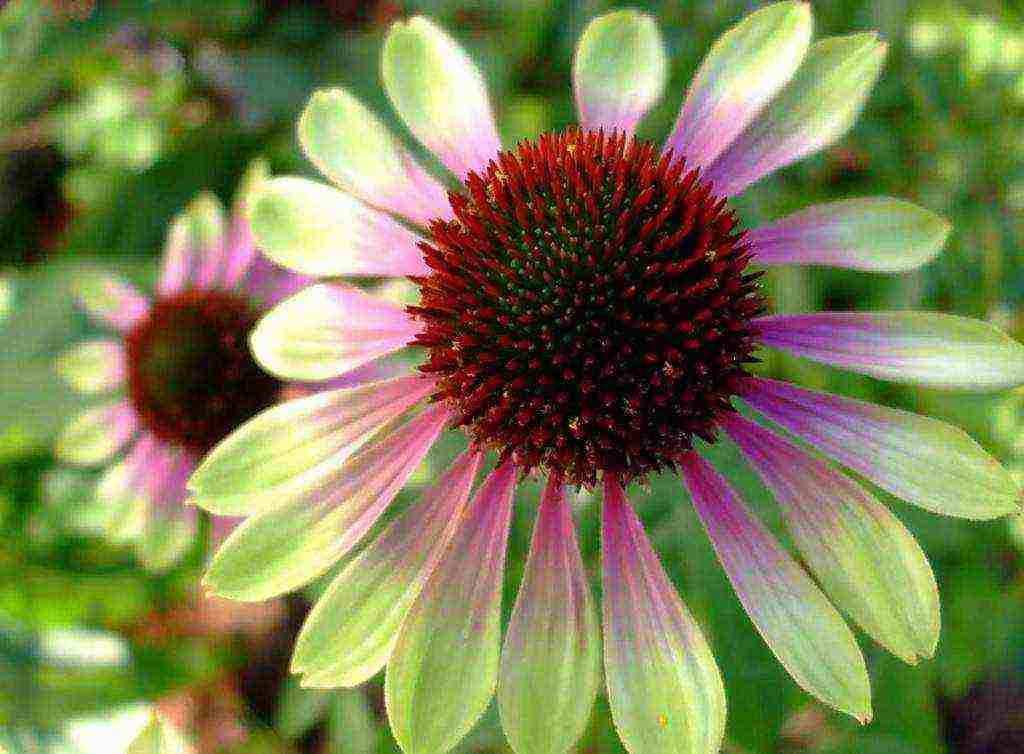

Echinacea (Echinacea) is a flowering ornamental herbaceous perennial from the Astrov family, whose homeland is considered to be the eastern part of North America. The genus consists of 9 species, but the most popular is Echinacea "Purple", which has medicinal properties and is used in folk and official medicine. There are many of its hybrids and varieties that are popular in culture. These are Sonnenlach with dark red flowers, Julia with orange flowers, Cleopatra with bright yellow flowers, Passion Flute with golden flowers, Cantaloupe with pinkish-orange flowers.
The culture consists of rhizomes, high straight stems with a rough surface up to 1-1.5 meters long, oval basal and stem leaves with denticles along the edge, large inflorescences of white, pink and red flowers and fruits - achenes.
Planting echinacea
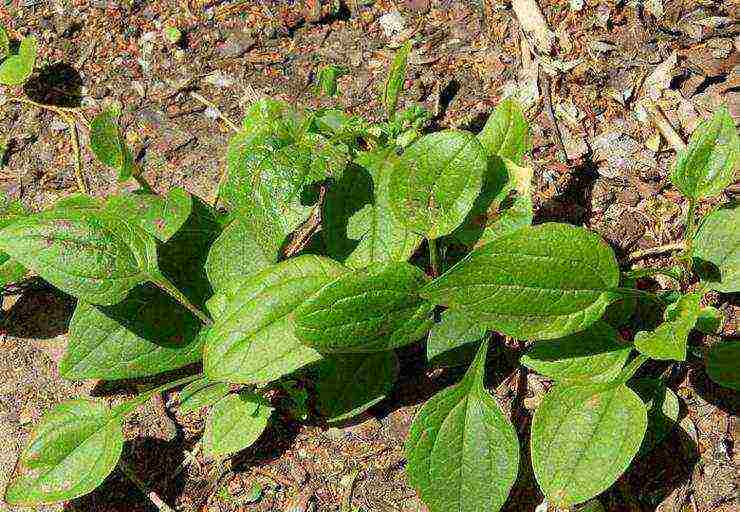
When to plant echinacea
Most often, planting is carried out after the plant has multiplied by dividing the bush, and this procedure can be carried out in early spring or early autumn.
Site selection and soil preparation
The echinacea planting site should be well lit by the sun during the day. If there is acidic soil on the future flower garden, you will need to dig it up along with lime. The most favorable place will be a fertile area after deep digging with a slightly alkaline or neutral soil composition. Light sandy soils and areas with high humidity will not work for the plant.
How to plant echinacea
Planting young seedlings, bush divisions and seedlings purchased in containers have their own characteristics. Seedlings are planted in planting holes 5 centimeters deep. At the bottom of the hole there is a small layer of compost. Sprinkle the plants with soil mixture and watered abundantly. For the cut, a hole is prepared with a depth of about 20 centimeters. A compost layer at the bottom and watering after planting is also required. It is recommended to plant seedlings purchased in containers by transshipment together with an earthen lump. In a hole about 40 centimeters deep, you need to pour a soil mixture of sand, garden soil and compost (in equal amounts) for about a third of the volume, and then place a seedling there. After filling the planting pit with earth, echinacea is watered.
Outdoor Echinacea Care
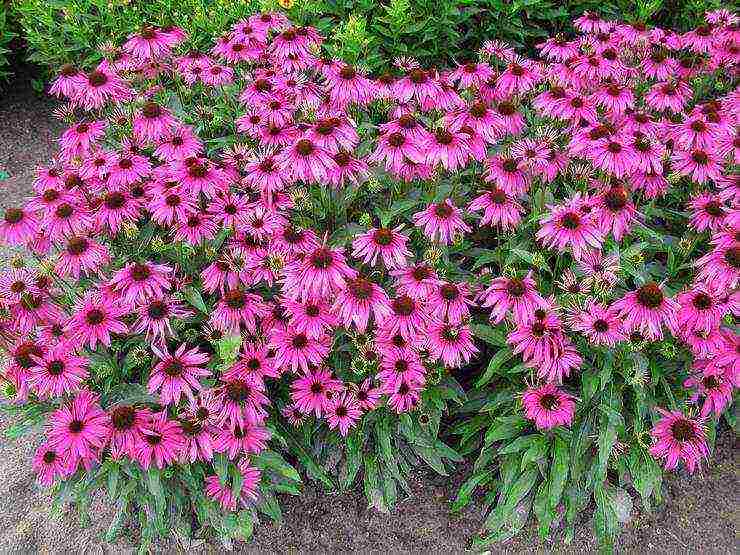
Caring for a flowering perennial does not take much time and effort, but requires attention and care.
Watering
Flowers require frequent and abundant watering, which is best done after sunset. One watering a day will be sufficient.
Weed control
Weed vegetation causes great harm to ornamental crops, therefore it is recommended to weed regularly and in a timely manner. It is necessary to remove weeds at the initial stage, when they have not yet begun to take nutrients useful for echinacea from the soil.
Top dressing and fertilizers
In the first year after planting, the flowers do not need to be fed. Fertilizers are recommended to be applied from the second year of life. It is necessary to maintain the flowers with additional fertilizing in early spring before flowering and after flowering. A complete fertilizer for the crop is a mixture of wood ash and rotted manure.
Pruning
When the flowering period ends, seeds ripen on the plants. They can be harvested for further reproduction. When the collection of seeds is not carried out, then it is worth pruning the wilted buds along with part of the stem.
Echinacea after flowering

Seed collection
The collection of seed material is carried out gradually, because the seeds do not all ripen at the same time. The collection begins at the end of the summer season. The seeds are in the middle of the basket-shaped inflorescence. The maturity of the seeds is determined by the darkened center of the flower. It is more convenient to collect them with gloves.It is recommended to lightly dry the seed and sow it immediately in open ground, since its germination capacity remains for a very short time.
Preparing for winter
The cold-resistant plant will perfectly survive the winter without shelter in the presence of a large snow cover or in moderate cold. If your area is dominated by severe frosts in the absence of snow during the winter months, then it is worth taking care of the plants in advance. In the first year after planting, young crops definitely need a protective structure to keep warm. In the fall, around the last week of October, all stems are pruned and mulched. The compost mulch should cover the root collar, and the entire flower garden should be covered with a layer of fallen leaves and spruce branches on top.
Reproduction of echinacea
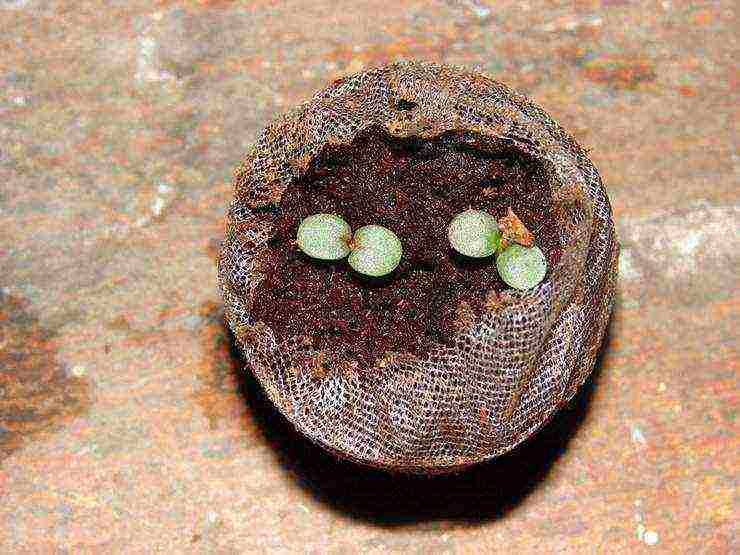
Reproduction by dividing the bush
A favorable time for this method is mid-spring or autumn. It is recommended to use plants four or five years old for separation. The bush must be carefully dug out, after watering it abundantly. Each divided part should have 3-4 growth buds.
Seed propagation
In early spring, seeds are sown on open flower beds, sprinkled with a thin layer of soil and watered. The temperature favorable for seed germination is 13-15 degrees Celsius. With spring temperature drops, the development and growth of delicate seedlings can be threatened. Therefore, it is better to use the seedling method.
Sowing seedlings is carried out at the end of winter. Planting boxes are filled with substrate, seeds are sown to a depth of 5 millimeters, ground with a thin layer of soil, crops are sprayed from a spray bottle and left in a warm room until shoots appear. After transplanting strong seedlings into open ground, full care will be required, which consists in regular watering, weeding and loosening. The first bloom will come next season.
Diseases and pests
Powdery mildew on echinacea is the result of an excess nitrogen content in top dressing, abundant and prolonged precipitation, as well as sudden temperature changes. Control measures - treatment of plants with Bordeaux liquid or colloidal sulfur.
Numerous spots on the leaves (cercospora or septoria) can completely destroy the culture, as they weaken its immunity. At an early stage, all affected leaves are removed, and in case of severe damage, fungicide treatment will be required.
There is no way to save flowers from viral diseases. Signs of the virus are yellowed and drying leaves, deformed peduncles. To protect healthy crops, it is recommended to urgently destroy diseased specimens (in a remote area), and shed a plot of land with a strong manganese solution.
To combat harmful insects, special chemicals are used - "Karbofos", "Actellik". Most often, Echinacea attracts drooling pennits and bedbugs. When slugs appear, you will have to collect them by hand, and as a preventive measure, you must use folk advice. For example, scatter a large amount of walnut shells around the flower garden. It will be a serious obstacle to the movement of gastropods.
With strict adherence to all the rules for growing and caring for diseases and pests, there will be no.
Benefits of Echinacea
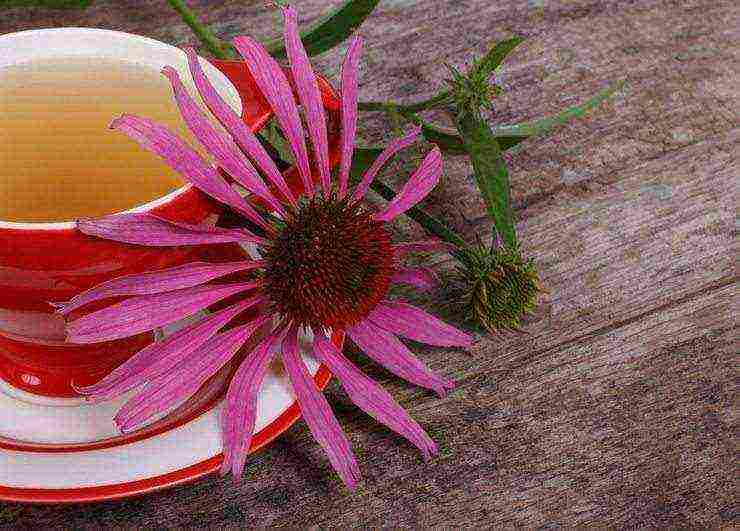
Echinacea is a medicinal herb, which (in the leaves, inflorescences and rhizomes) contains a huge amount of nutrients and elements. Essential oils and organic acids, tannins and polysaccharides, resins and fatty oils, macro (calcium and potassium) and trace elements (cobalt, silver, zinc, manganese and others) - all this allows you to fight many complex diseases. Fresh juice, tinctures, decoctions and other preparations from echinacea kill germs and fungi, heal wounds, strengthen the immune system, have a sedative and antiviral effect, increase male strength and accelerate blood clotting.
The medicinal perennial is known in many European and Asian countries, it is popular in Russia and the CIS countries. Official medicine compares the medicinal properties of echinacea to ginseng.Drugs based on this culture (for example, echinacin) are able to cure various inflammatory diseases associated with the respiratory system and chronic infectious diseases (for example, tuberculosis).
In folk medicine, there are many recipes for decoctions and tinctures that can be prepared at home if the flower grows on the site.
Tincture for the treatment of depression and overwork, as well as for the fight against various infections is prepared from freshly cut echinacea inflorescences. A half-liter jar must be filled to the top with flowers, filled with vodka, tightly closed and put in a dark place. After 40 days, the tincture is ready for use. It is filtered and taken 30 minutes before meals in a diluted form. For 100 milliliters of water - 15 drops of tincture.
A decoction made from the root part is recommended for colds and infectious diseases, as well as for chronic fatigue. The root must be crushed, filled with water, put in a water bath for thirty minutes, and then set aside for gradual cooling. For half a liter of water - about 2 tablespoons of chopped roots. Strain the broth before use. Drink before meals 3-4 times a day, one or two tablespoons.
For all its usefulness and popularity, echinacea can cause an allergic reaction. That is why you should not self-medicate. It is safer to take medications based on this herb only after consulting a specialist. This is especially true for people with various chronic and acute infectious diseases, as well as nursing mothers and pregnant women.
Echinacea: how to grow on the site, the benefits of echinacea (video)
Posted in: Medicinal plants, Flower garden
Echinacea a flower that surprisingly combines exquisite beauty and unique healing properties. This plant has long and firmly established itself in our flower beds and flower beds.
A little about the plant
Echinacea is native to South America. It has been known there since time immemorial. The Indians, the indigenous inhabitants of those places, gave it a romantic name - "Evening Sun". Pretty accurate name. Especially in relation to the most common species in our country - "Echinacea purpurea". Sometimes there is another name for it - "Purple rudbeckia". It is believed that Karl Linnaeus himself named it so, who described it and placed it in the Rudbecky genus. But over time, this decision was revised, and echinacea was allocated to a completely separate genus of the "Astrovye" family. Unlike the Indian name, the translation of the name of this plant from Greek into our native language is less romantic. Echinacea (Echinacea) - prickly. This is a rather tall flower, often reaching a height of 1.5 meters. It blooms profusely and for a long time with beautiful large flowers, leaving behind a considerable amount of seeds in the achene fruit. It is this fruit that bristles with seeds - thorns, which gave the name to the flower. In addition to Echinacea purpurea, other varieties have been bred that are different in color: pink-orange (Cantaloupe variety), yellow (Cleopatra variety), dark red (Sonnelach variety), orange (Julia variety), golden (Passion Flut variety).
Growing echinacea from seeds
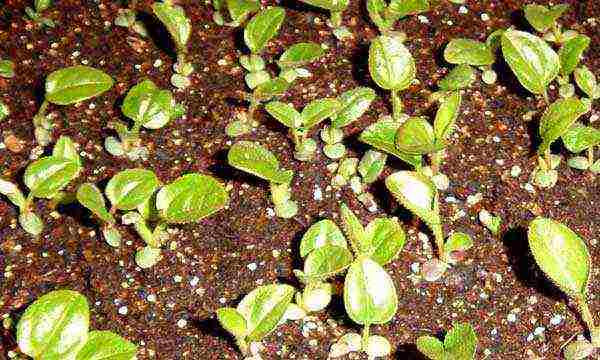
Note!
When propagated by seeds, the varietal characteristics of the plant are not preserved. So it is possible to multiply mainly "Echinacea purpurea". For varietal and hybrid plants, propagation by dividing the bush is used.
As mentioned, after flowering, echinacea leaves a large number of seeds. So they should be used for reproduction. This can be done by sowing them directly in open ground or by growing seedlings.
Echinacea seeds are sown in open ground in spring, when the ground is warm enough. The most acceptable temperature for their germination is within + 12-13 degrees. Seeds are simply scattered over the surface of the ground and covered with a thin layer of earth. Seed rejection can be carried out in advance.To do this, they must be placed in a glass of warm water for a couple of days. Those seeds that sink to the bottom will be suitable for sowing.
But this method, although easy, has a drawback. In capricious spring weather, the delicate sprouts of Echinacea are easily damaged and do not survive. It is much safer to grow seedlings.
Growing Echinacea seedlings
Sowing of seeds is carried out at the end of February - March. Selected seeds are sown in containers with light soil to a depth of no more than 0.5 centimeters. After sowing, the soil is moistened with a spray bottle, covered with transparent material to create greenhouse conditions and placed in a warm place for germination. It will take a long time to wait for the emergence of echinacea shoots. Sometimes the wait lasts 40 - 45 days. During this time, check soil moisture and ventilate the container. After sprouting, care for Echinacea seedlings is the same as for seedlings of other flowers and vegetables. When the seedlings are strong enough and the weather is warm, the seedlings can be planted in open ground.
Note!
Echinacea grown from seeds gains strength in the first year and does not bloom. This year it will only be able to grow a leaf rosette 20 centimeters high. Flowering will come next year.
Echinacea propagation by dividing the bush
Only adults, sufficiently dense bushes of a plant, about 4-5 years old, are suitable for separation. The division is carried out both in the spring (April) and in the fall (October). When digging up a bush, you should be careful not to damage the root system. First, the bush must be watered abundantly, this will facilitate its extraction. The roots peeled from the ground are carefully cut into the required number of divisions. Each of them must have three to four renewal buds.
Planting echinacea outdoors
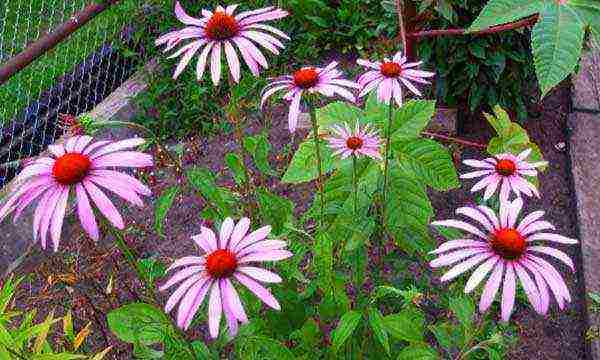
Seed-grown plants are planted in spring, while split bushes can be planted in both spring and fall.
Choose a well-lit area with fertile soil for planting. Echinacea does not like acidic earth. If necessary, deoxidize it. It is ideal to add dolomite flour to the ground, but ordinary liming can also be carried out. Also, avoid planting in sandy soil and in places with stagnant water that are too wet.
For planting echinacea seedlings, make small holes 5 centimeters deep. But basically, this depth will depend on the size of your seedlings, its root system. Keep the distance between seedlings in a group planting 30 centimeters. Roughly the same pattern is maintained for planting a part of the echinacea bush. Only make the planting hole slightly larger than the size of the plant's root system. It is advisable to pour a small amount of compost or humus soil on the bottom of the holes. In this case, make the size of the landing hole for echinacea taking into account such an additive.
Echinacea care
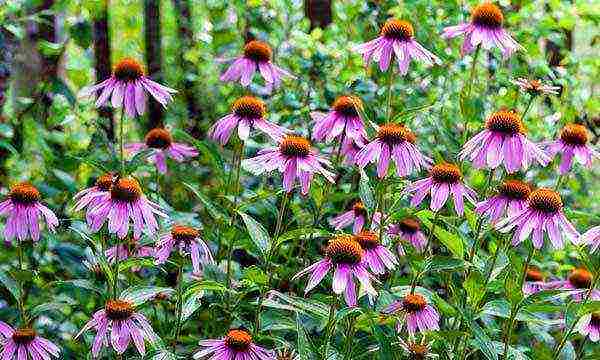
Watering
Echinacea loves frequent and abundant watering. If the summer is not rainy, then it is advisable to water it daily. Do not water the plant in the heat of the day. The most favorable time for this is after sunset.
Top dressing
Echinacea can be fertilized only in the second year of life, when it is about to bloom. Fertilizers are applied twice. The first time - before flowering, in the spring and the second time - at the end of the flowering period. You can use ready-made mineral fertilizers, but feeding with a mixture of ash (ash) and well-rotted manure is most preferable.
Pruning and collecting seeds
After the plant has bloomed, all the wilted flowers must be removed along with a small section of the stem. But if you plan to harvest the seeds, then they should be given a little time to ripen. You can determine the maturity of echinacea seeds by the shade of the seed basket. Ripe seeds are usually dark, almost black in color.
Important!
Echinacea seeds and quickly lose their germination. Therefore, it makes no sense to store them for a long time.
Wintering
In most regions, this flower tolerates winter without much difficulty. But if your winters are cold, then you should take care of the echinacea shelter for the winter. This is especially critical for plants of the first year of life. Adult plants are pruned before the onset of frost, the root collar is sprinkled with compost or sawdust, and the soil around the roots is mulched with sawdust, fallen leaves, peat, etc. If winter is expected to be harsh, it is advisable to cover the plant with spruce branches.
The healing properties of echinacea
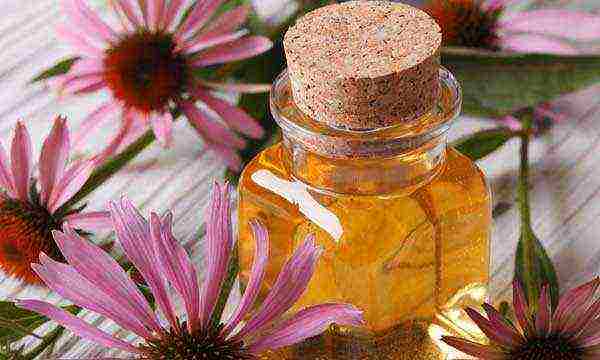
What is especially valuable about this plant is its antiviral and antiseptic properties. The elements contained in echinacea counteract the multiplication of pathogenic bacteria, viruses, infections. It is used in the treatment and prevention of influenza, tonsillitis, colds and diseases of the upper respiratory tract. Used as an anti-allergic, anti-inflammatory, anti-rheumatic agent. Echinacea successfully fights various fungal diseases, heals wounds and ulcers, strengthens the general immunity. And these are not all the beneficial properties of echinacea.
What is great is that almost all parts of the plant are suitable for the preparation of medicinal infusions, decoctions, etc.
Echinacea decoction
This simple remedy well eliminates pain in the joints, swelling, improves vision, and is used in the treatment of stomach ulcers. After taking such a decoction, the mood improves.
Preparation of the broth
Based on one glass of boiling water, a teaspoon of crushed echinacea leaves is taken. Moreover, you can use both fresh and dried leaves. Leaves filled with boiling water should be held for half an hour in a water bath. After straining and cooling, the broth is ready for use.
Receiving broth
The usual course of taking it lasts 10 days. It consists of taking 30 milliliters of broth three times a day after meals. If you need to take several such courses, then a week break between them is required.
Echinacea infusion
It is recommended if you are overweight, signs of the onset of obesity. It is used in the treatment of gynecological diseases, herpes. But its main and most common purpose is to strengthen the general immunity of the body.
Preparation of infusion
The infusion should be prepared in an airtight, well-sealed container. At the rate of half a liter, a tablespoon of echinacea (dried or fresh parts) is taken. A thermos is best for preparing an infusion of echinacea. If the infusion is prepared in the evening, then in the morning it will be ready.
Reception of infusion
Take the infusion for 10 days (if there are no individual recommendations), three times a day before meals (25-30 minutes), 100 milliliters at a time. After completing one course, there must be a break of at least 5 days. After three courses in a row, a break of at least a month.
Important!
For all its naturalness, echinacea preparations may have contraindications. This is both an individual intolerance to the components of the drug, and an allergic reaction to them. Echinacea is also contraindicated in a number of diseases. Before you start taking it, consult your doctor!
How to grow echinacea and its benefits (video)
Tell your friends about the article and the site. Just press the button of your favorite social network ...
Thanks!!!
Have you noticed a mistake in the text?
Select it with the mouse and press Ctrl + Enter

